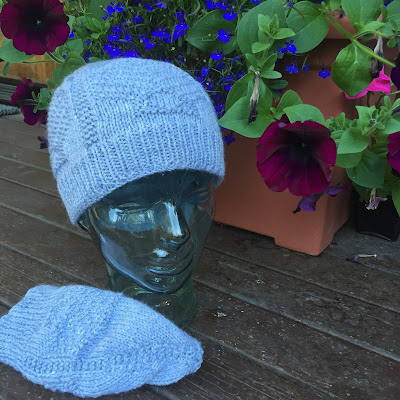So I was absolutely elated to find that I could take a class in Cordova from a true natural dye expert, Kathy Hatori of Botanical Colors. I had read enough about indigo to know that it was an art, not just a 1 2 3 set of instructions.
The class was held outdoors, at a cabin by Eyak Lake. It's a great idea to dye outdoors, for obvious color-drippy reasons.
Here's our class space--a propane burner and vat for each student, with various dyed and undyed skeins hanging about. The magenta and golden skeins were for overdying with indigo. I was so preoccupied with turning white yarn blue, I never got around to the overdyes.
My main aim was to dye my 6 skeins of Cormo wool from a Juniper Moon CSA share bought last year. My plan was to just plainly dye two skeins, dye two skeins shibori-style with resist areas, and do an ombre job on the last two.
First up was the process of making the vat: stirring up the indigo powder with a little henna and calcium hydroxide. We started in quart jars and eventually progressed to the big pots of warm water. Because making indigo dye is an organic process, there's some waiting time, but eventually you get your vat ready to go, and it looks like this:
Bubbly scum on top, and a metallic sheen. The top of the vat is blue because the dye has oxidized in contact with the air, but the liquid below the surface is a green tea color. As you proceed with your dyeing, you must constantly check the color of the dye solution, and rebalance it with additions of fructose when it veers from that tea green.
One thing you quickly learn about indigo is that your fiber exits the vat not blue, but green. Then with exposure to air, the dye oxidizes and turns blue. Intensity and depth of color is not so much the strength of the dye solution, but the number of times the item has been in and out of the vat, each dip with a pause to air and oxidize.
Here is the pair of cormo skeins tied with rubber bands and ready to go in:
And here is a pair of the plain skeins after a couple of trips to the vat:

They look a bit uneven because they have picked up some of the powder from the bottom of the vat. A plain water rinse evened them out and neutralized the pH from the dye solution.
Here are my products of the day, posed with some fishnets for added ambiance--The darker blues are the plain skeins, the lighter ones the shibori and the other two. Plus the colorful non-overdyes. Time and the waning strength of my dye vat made my later skeins much lighter than the first two, and the ombre version a goal for the next time.
Yarn is famously not the only thing that turns blue on indigo day. Indigo dyers are known for their blue hands. Though I wore gloves during the actual dyeing, I got a little blue in the paws just from handling the yarn to reskein it before its final rinse.













